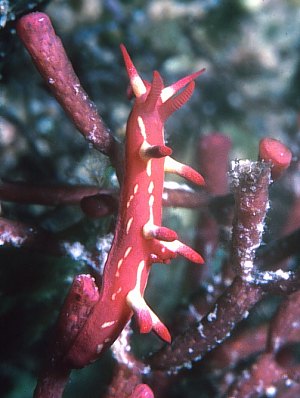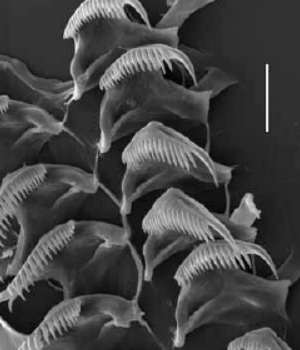

Okenia kondoi
(Hamatani, 2001)
Order: NUDIBRANCHIA
Suborder: DORIDINA
Superfamily: ANADORIDOIDEA
Family: Goniodorididae
DISTRIBUTION
This species is known from the Kuroshima Islands (Japan), Bohol and Cebu Islands (Philippines) and Enewetak and Kwajalein Atolls (Marshall Islands) (see Gosliner, 2004).
PHOTO
Upper: Cement Ship Pinnacle, Enewetak Atoll; in ledge on bryozoan, 25m, 21 August 1983 [7x1,7x1.5,3x.75mm], Photo: Scott Johnson. Lower: SEM of radula, showing part of right side (CASIZ 106551). Scale bar = 35 µm. Photo: T.M. Gosliner.
NOTE: This species was formerly known on the Forum as Sakishimaia kondoi
The surface of the animal is a dull and opaque red. The rhinophores, latero-dorsal appendages, gills, oral shield and foot sole are similar in colour to the body, though the dorsal appendages are whitish over the proximal half of their length. The body is elongated and limaciform, with no pallial margin. There are 4 dorso-lateral appendages along each side of the dorsum, with a single appendage appearing in the midline in front of the gills. Hamatani considers the 6 appendages behind the rhinophores to be different from the anterior pair which he calls 'oral tentacles'. Although they may function as anterior tentacles they do not arise from the oral shield and I would consider them to be the anterior-most of the dorso-lateral appendages. The oral shield is triangular in shape. There are three simply pinnate, non-retractile gills. It rows to approximately 13mm long.
The radula is very similar to that of Okenia hallucigenia. The inner lateral teeth have a broad base and a blade which ends in a bicuspid tip. A medio-dorsal groove runs down the distal half of the tooth. There are up to 16 very long denticles along the cutting edge of the tooth. The much smaller outer teeth have a broadly quadrangular shape with up to 3 or 4 remnant cusps..
This species was originally placed in a new genus, Sakishimaia, on the cylindrical shape of the body, complete absence of the mantle edge, peculiar shape of the head, and absence of second lateral teeth. Gosliner (2004) shows that the second lateral teeth are present, and the other characters are part of a continuum of gradual change. He places this species, and related species of Hopkinsia, in the genus Okenia. It is very similar on colour to O. nakamotoensis which shares the same geographic range and the same bryozoan prey, Tropidozoum cellariforme Harmer, 1957, but differs in having a more slender shape and in radular morphology. It also differs from that species in having 4 pairs of dorso-lateral processes rather then 5. A similar species pair from northern Australia, O. stellata and O. hallucigenia have recently been described (Rudman, 2004).
-
Hamatani, I. (2001) Two new species of Goniodorididae (Opisthobranchia; Nudibranchia) with a new genus from Kuroshima Island, Okinawa, Japan. Venus, 60(3): 151-156.
-
Gosliner, T. M. (2004) Phylogenetic Systematics of Okenia, Sakishimaia, Hopkinsiella and Hopkinsia (Nudibranchia: Goniodorididae) with descriptions of new species from the tropical Indo-Pacific. Proceedings of the California Academy of Sciences, 55: 125-161.
-
Rudman, W.B. (2004) Further species of the opisthobranch genus Okenia (Nudibranchia: Goniodorididae) from the Indo-West Pacific. Zootaxa, 695: 1-70.
ARCHIVE NOTE: An earlier edition of this Fact Sheet [14 February 2002] as Sakishimaia kondoi is available on request.
Authorship detailsRudman, W.B., 2004 (December 21) Okenia kondoi (Hamatani, 2001). [In] Sea Slug Forum. Australian Museum, Sydney. Available from http://www.seaslugforum.net/find/sakikond
Related messages
Sakishimaia kondoi from the Marshall Ids
March 4, 2002
From: Scott Johnson

Hi Bill,
To accompany the photos of the specimens of Hopkinsia nakamotoensis from Kwajalein, Marshall Islands here is a photo of one from Enewetak Atoll. It is one of a few specimens I found under somewhat similar circumstances at Enewetak Atoll. The Enewetak specimens were also in ledges on a bryozoan on a lagoon pinnacle, but this pinnacle was immediately to the west of the atoll's deep water pass, subjecting it to frequent in and out currents not experienced by the Kwajalein pinnacle.
Data: 21 August 1983 7x1,7x1.5,3x.75mm; Cement Ship Pinnacle, Enewetak Atoll; in ledge on bryozoan, 25m,
Scott Johnson
johnson@kmr.ll.mit.edu
Johnson, S., 2002 (Mar 4) Sakishimaia kondoi from the Marshall Ids. [Message in] Sea Slug Forum. Australian Museum, Sydney. Available from http://www.seaslugforum.net/find/6350Thanks Scott,
I suspect this is in fact Hamatani's other species Sakishimaia kondoi which differes from Hopkinsia nakamotoensis in having 4 rather than 5 pairs of dorso-lateral processes, and in having a much more slender body. I may of course be wrong, but it certainly seems to fit Hamatani's description. We would need to look at its radula to be sure. I know realise why I have been somewhat confused with Hamatani's description. He differentiates the 6 dorso-lateral processes behind the rhinophores from the pair in front which he calls 'oral tentacles'. Although the anterior pair may serve that function they appear to arise not from the oral veil but from the mantle edge and so are best considered homologous with the other dorso-lateral processes. Any comments gratefully received.
Best wishes,
Bill Rudman
